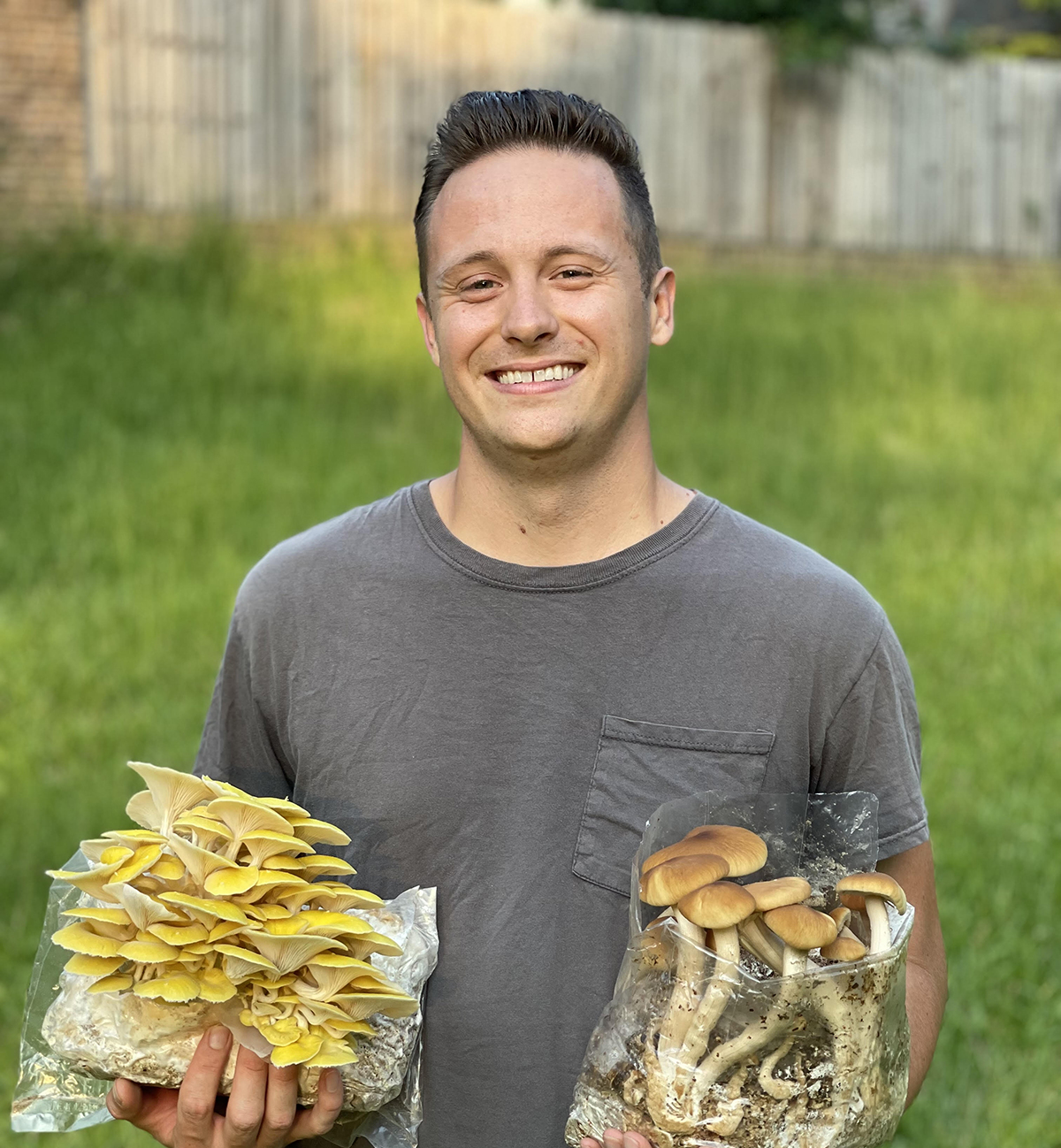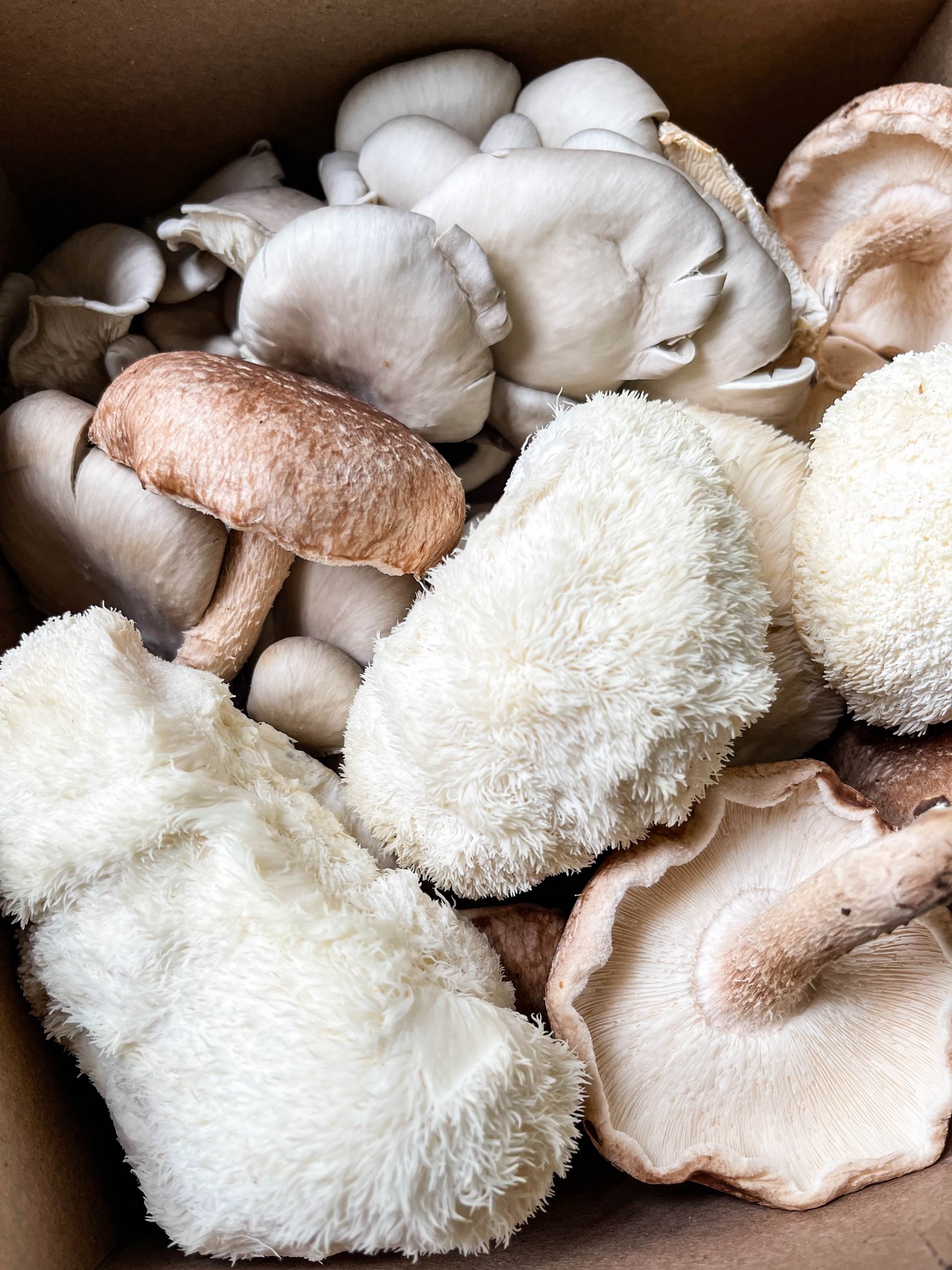
Joel Tharpe of Mycelial Minds knows all things mushrooms: growing, foraging, harvesting and thanks to his culinary background at some of Atlanta's best restaurants, cooking them, too! This week Joel's lion's mane mushrooms are in our Lion's Mane "Crab" Cakes meal kit as a sneaky swap for crab–lion's mane mushrooms are known for their meaty flavor and tender texture, both reminiscent of shellfish. They are often used in place of crab, scallops, and lobster. Bonus: they are really good for you! Lion's mane mushrooms are known to improve heart health, reduce blood sugar, and even aid with symptoms of anxiety and depression. Who knew?!
We asked Joel some questions about what led him to start Mycelial Minds, all about how mushrooms are grown and foraged, and so much more! Read on to learn more, and order the Lion's Mane "Crab" Cakes meal kit here.
1. How and when did you start Mycelial Minds? What experiences led you here?
I officially started Mycelial Minds back in August of 2023, so we’re still a pretty young farm but my experience with mushrooms predates that by quite a bit. I started getting interested while working at Atlas Restaurant in Buckhead back in 2017. A fellow co-worker was a mushroom forager and during the summer would bring in crates of chanterelles he found in the woods around the city. I was immediately intrigued by the idea of going out into the woods and being able to come out with something, not only edible, but also delicious. So after talking with him about it I decided to go get my mushroom foraging certification (yep, that’s a real thing) to be able to safely identify the mushroom species we have here in the Southeast. After that it was basically a rabbit hole for me. The more I learned about mushrooms the more I thought they were interesting and incredible organisms. I knew I eventually wanted to get into cultivation but it wasn’t until recently that my wife and I moved into a larger house with a significant amount of land that I really had the option to pursue it.
2. What kinds of mushrooms do you grow? Do you have a favorite?
We currently grow 4 varieties consistently and those are Shiitakes, Blue Oysters, King Oysters, and Lion’s Mane. Trying to pick a favorite is so difficult because they’re all so unique in their own way and I really love them each for different reasons. I love growing the blue oysters the most, mostly because they’re one of the most virulent strains and very forgiving, so they’re great for people just getting into mushroom cultivation. They also grow in these beautiful clusters that are just fun to watch develop from pins to full blown mushrooms in just a few days. If I had to choose, from a culinary perspective, you can’t beat the king oyster though. It has an incredibly dense texture that works as a fantastic meat substitute in any number of dishes. I’ve seen them marinated and then seared or grilled, as well as smoked and sliced into “vegan bacon”, which I hear is actually pretty good.

3. Could you give us a quick run-down of how mushrooms are grown?
So the way that mushrooms are grown depends entirely on the species. We exclusively grow what are known as xylophagous, or wood loving, species of mushrooms. Others, such as the common button mushroom, are typically grown on composted animal manures and other materials, and then you have mycorrhizal fungi, such as the chanterelle, which humans haven’t figured out how to cultivate, and thus can only be found growing wild.
The cultivation process for us begins in a petri dish, with a tiny sample of spores, a piece of mushroom tissue, or a previously established agar or liquid culture. From there the mycelium, the underground living part of the mushroom, spreads through the agar in the petri dish, eating up all of the nutrients until it has completely taken it over. We then take a slice of this agar and transfer it, under extremely clean conditions, to a bag of cooked grain to create what we call grain spawn. Once that grain is fully taken over we transfer this to bags of hardwood sawdust spawn which is what the mushrooms will eventually fruit out of. Once the grain is transferred to the sawdust, the bags are sealed and allowed to incubate for a period of 3 weeks for some varieties and up to 12 weeks for others. When these bags are fully colonized a simple slit in the side allows oxygen to flood in letting the mycelium know it's time to fruit and then a week or 2 later we have a big flush of mushrooms!
4. What is the hardest part of growing mushrooms?
I would say one of the most difficult parts of growing mushrooms is trying to achieve consistency. We provide the mushrooms with the most ideal growing conditions we can but at the end of the day you’re still dealing with nature and sometimes the mushrooms fruit faster than you want, and sometimes they fruit slower. Luckily for us people usually understand that there is some variability in any type of agricultural cultivation, especially on the small, local level, and would prefer a bit of inconsistency to the alternative of effectively factory farmed agricultural products.
The other difficulty is all of the knowledge you have to gain that has nothing to do with mushrooms or mycology. After learning everything about mushrooms and how they grow I very quickly learned that I’d also need to know about creating and maintaining humidity, temperature controlling our fruiting chambers, and filtering out spores so they didn’t clog our equipment.
5. What about foraging them?
When it comes to foraging none of it is particularly difficult because the mushrooms and nature have done all of the work for you, but you have to use extreme caution and be very knowledgeable due to poisonous species. That’s the main reason why I recommend anyone who wants to start foraging to get certified first because there are species out there that look perfectly harmless but can kill a human in 48 hours. The certification is a requirement for anyone like me who sells their mushrooms to grocery stores or restaurants, but even for the hobbyist I find it's extremely helpful to go through that process. While that aspect of foraging can be a bit frightening for some people it is an incredibly fun and rewarding experience. The feeling you get from happening onto a huge flush of bright orange chanterelles is extremely gratifying. And even if you don’t find anything, at the very least you just had a nice little walk through the woods, which is something most of us don’t get enough of.
6. Do you have any go-to recipes for cooking with your mushrooms?
When it comes to cooking each variety really shines in different ways but there are a few rules of thumb that apply across each of them. For the most part when cooking mushrooms you want to cook them hot and fast. The reason being is that mushrooms are 95% water and you want to get almost all of that water out of them as fast as you can. Otherwise, you’re going to have soggy mushrooms and who likes that? You also want to make sure you don’t crowd the pan when cooking them. This will cause them to cook unevenly and also won’t allow them to cook fast enough, leading again to soggy mushrooms.
For varieties like shiitakes and oysters, I like to sauté them in olive oil in a hot pan until nicely browned. They can be served on their own like this or mixed into stir fries, used in lieu of meat in burritos or tacos, or tossed with a sauce into pasta. My most recent obsession has been to sauté oysters, toss them in pesto, and then top homemade pizza with them.
For a variety like lion’s mane the best way to use them is either going to slice them thick into a steak and sear them or shred them to use as a substitute for shellfish. If going the steak route feel free to marinate them the way you would with beef or pork, in a liquid marinade or dry rub. Just be prepared to cook that additional liquid out of them. If shredded they can be used to make crab cakes, battered and fried to make po boys, or sautéed and tossed with pasta.
7. What are a few of your favorite restaurants in Atlanta?
I’m going to be extremely biased here due to my association with so many people in the restaurant industry but these are truly some of the best spots in the city.
Lazy Betty, which just moved to Midtown, is, in my opinion, the best restaurant in the city. Their chef de cuisine, Austin Goetzman, is a very good personal friend of mine from back when we worked together at Atlas but he truly is one of the most talented chefs I’ve ever met. They recently received their first Michelin star this past year and deserve every bit of it. It certainly isn’t the least expensive place in the city but in my opinion it's completely worth the price.
Next I absolutely have to acknowledge Atlas in the St. Regis Hotel in Buckhead. This was where I really dove into the food world and really started to understand what good food is and the importance of locally sourced produce and products. They have also just received their first Michelin star and are an absolute destination if you’re looking for the peak of luxury in the city of Atlanta.
And last but certainly not least is The Chastain, helmed by my former executive chef, Chris Grossman. Chris has effectively taken the quality that we focused on at Atlas and applied it in a way that’s very accessible for everyone. Chris and I also share a lot of the same beliefs about the importance of local agriculture and food and I learned a lot of what I wanted Mycelial Minds to be from him, before I’d even dreamed it up.
8. What does being part of the local food community here in Georgia mean to you?
I think it really means everything to us. When I started Mycelial Minds our main focus has been sustainability and trying to bridge a gap between the current commercial model of mycoculture and smaller, local mycoculture. A little known fact about mushroom production is that 95% of the button mushrooms we eat here in the US are grown in China.
We wanted to create a new model that focuses on smaller, local farms, growing high quality mushrooms just a few miles from where they’ll be eaten. The way we grow mushrooms can easily be replicated to meet an entire city’s needs while still staying true to our environmental commitments and principles. In my opinion the way we grow and distribute food right now as a country is in huge need of an overhaul. We’ve thrown quality, seasonality, and locality out the door in exchange for convenience and at the expense of the environment.
At Mycelial Minds we do everything we can to be good stewards of our environment. We compost all of our spent substrate after its done fruiting, we recycle all of the plastics we have to use, and exclusively use fully electric vehicles for all of our transport and deliveries. As we grow and look to expand we plan to take these commitments even further by investing in fully solar powered facilities and hopefully expanding our operations to other cities in Georgia and the Southeast as a whole.
ORDER THE LION'S MANE "CRAB" CAKE KIT >>
